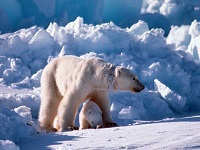World's strongest powers get ready to fight for Arctic riches
Deputy Prime Minister Dmitry Rogozin's strong statement that Russian oil and gas facilities in the Arctic could become the target of sabotage on the part of other countries has already caused plenty of discussion. This statement was made at the conference held in Moscow with a very "telling" name - "Being strong: guarantees to the Russian national security."
"An active development of the Arctic shelf will inevitably lead to a conflict of interests between countries. Addressing these conflicts may go beyond diplomatic means. It is likely that Russian oil and gas production facilities become targets of hidden sabotage by competitor countries," said Rogozin.
Such strong statements are not made by state officials out of the blue. Obviously, there are reasons for these words.

According to some reports, the U.S. has recently approved the so-called "Arctic Action Plan", as well as a number of policy documents on national security. These documents explicitly stress that the Americans have broad interests in the Arctic region, and the United States is willing to promote them in every way.
But the United States is not the only country that indicated the intention to firmly defend their interests. Today, the world has witnessed a surge of interest in the Arctic. The main reason is that many countries, not only polar ones, are prepared to invest heavily in the development of the rich natural resources of the macro-region. It is not ruled out that the secret services of some countries particularly interested in obtaining "Arctic" profits may really choose some drastic measures.
The Arctic is one of the few places on the planet that has not yet been nationally defined. Initially the Arctic resources were not clearly divided between countries. The arctic zone is now claimed by at least five countries: Russia, Norway, Denmark, Canada and the United States. All of them have direct access to the Arctic Ocean. National claims may in the future be supported by different arguments, but it is clear that the main ones are practical, and there is a real willingness to actively explore the north.
The contradictions between the countries interested in the Arctic, according to some international analysts, may well lead to an increase in the international tension and a likelihood of emergence of international conflicts of local nature in particular. After all, there is something to fight for, and conflicts may arise.
Analysts point out several causes of the aggravation of the geopolitical struggle in the Arctic. The main ones among them are the current status of the national borders in the region that is not legally defined, rich subsoil resources, and the strategic importance of the Arctic region's transportation arteries.
In accordance with the international law, the length of the continental shelf of a maritime boundary is 200 nautical miles from the coast (the so-called economic zone). At the same time, the UN Convention on the Law of the Sea provides for the possibility that if a country can prove that the continental shelf of the Arctic Ocean is an extension of its continental platform, this part of the Arctic shelf will be recognized as its territory.
That is why in recent years the activity of Russia in the Arctic (e.g., expedition "Arktika-2007" in the North Pole and the expedition of the research vessel "Akademik Fedorov" and the atomic icebreaker "Yamal" in 2010) caused an extremely harsh negative reaction in the West. After all, their main task is precisely the collection of materials to support the right of Russia to expand its economic zone to the Arctic Ocean.
For example, the Russian application to the UN Commission on the outer limits of the continental shelf proposed to consider the underwater Lomonosov Ridge that passes under the eternal ice of the North Pole a continuation of the Siberian continental platform. The same applies to the Mendeleev Ridge, located to the east. Legally, this means that the requested areas are located in the "continental shelf" owned by Russia.
Not that long ago Denmark held its own Arctic expedition. However, its results were largely disappointing to its organizers, as the goals for the collection of evidence that polar areas belong to Denmark have not been achieved. Canada, incidentally, insists that the Lomonosov Ridge in the Arctic is part of its territory, and it is still going to prove it to the UN.
In turn, the United States claims the part of the seabed in the northern part of the Chukchi Plateau that borders Alaska. To prove their rights in this area the Americans also sent their expeditions. However, under the international law, the United States can assert their claims only to a relatively small sector of the Arctic. Now Washington proposes the international use of the Arctic resources and the need for an open access for multinational corporations.
Norway also has a serious geopolitical position. In 2006 it stated to the UN that the Lomonosov Ridge started on its territory. However, the Scandinavian country failed to substantiate their claims with research. In addition, in recent years Germany, South Korea and China have been increasingly active in the Arctic. China is trying to acquire 300 square kilometers of Iceland's island area in order to create their outpost on the way from China to Europe and back through the Northern Sea Route. Obviously, many countries are prepared for a serious fight for the Arctic.
Incidentally, the Deputy Prime Minister Dmitry Rogozin also stressed at the conference that in order to strike back and determine the extent of the use of force, it is necessary not only to identify the threats but also their initiator.
"This requires advanced monitoring devices that can operate in the air and water. So far, we do not have such devices ... In addition, NATO has long discussed plans to strengthen the naval group in the Arctic region under the pretext of commercial shipping," said the Deputy Prime Minister. According to Dmitry Rogozin, the Arctic now needs a completely new program, comparable in scale to the nuclear and missile ones.
How can Russia compete with its apparent competitors in the Arctic development? In fact, a lot is being done already for the protection of the circumpolar interests. The plans for the development of the Russian Arctic include clear targets for the development of a new icebreaking fleet. At the same time, Dmitry Rogozin during his recent visit to the Baltic shipbuilding plant in St. Petersburg said that investment into production vessels will reduce the shipping costs and speed up the pace of production. The Deputy Prime Minister inspected the world's first floating nuclear power station "Academician Lomonosov" that is currently under construction. It is expected to provide the infrastructure for the development of centers of polar continental shelf.
Now a head diesel and nuclear-powered icebreakers are under completion at the Baltic plant. A diesel "Iceberg" is being built for Rosmorport. Its construction is estimated at 7.9 billion rubles, and should be completed by October 2015. The innovative icebreaker comes with a price tag of 30 billion rubles and will be the most powerful ship of this class in the world.
It appears that it is insufficient to show the United Nations that Russia is the owner of a large part of the Arctic shelf. It also has to seriously defend its interests from the encroachment of competitors.
Andrei Mikhailov
Pravda.Ru
Subscribe to Pravda.Ru Telegram channel, Facebook, RSS!





